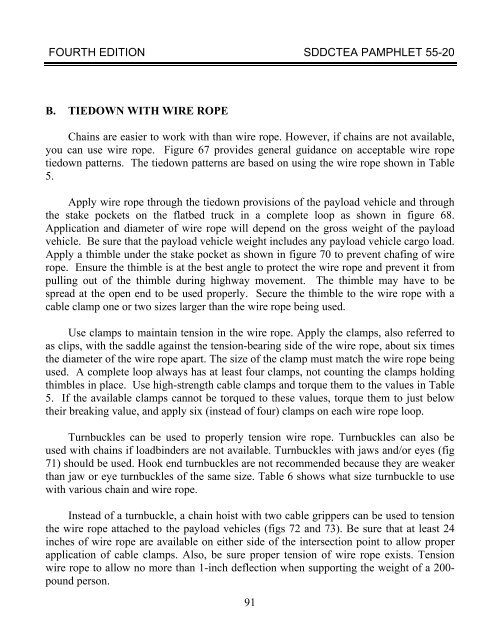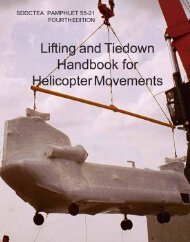TEA PAM 55-20 Tiedown Handbook for Truck - Military Surface ...
TEA PAM 55-20 Tiedown Handbook for Truck - Military Surface ...
TEA PAM 55-20 Tiedown Handbook for Truck - Military Surface ...
Create successful ePaper yourself
Turn your PDF publications into a flip-book with our unique Google optimized e-Paper software.
FOURTH EDITION SDDC<strong>TEA</strong> <strong>PAM</strong>PHLET <strong>55</strong>-<strong>20</strong><br />
B. TIEDOWN WITH WIRE ROPE<br />
Chains are easier to work with than wire rope. However, if chains are not available,<br />
you can use wire rope. Figure 67 provides general guidance on acceptable wire rope<br />
tiedown patterns. The tiedown patterns are based on using the wire rope shown in Table<br />
5.<br />
Apply wire rope through the tiedown provisions of the payload vehicle and through<br />
the stake pockets on the flatbed truck in a complete loop as shown in figure 68.<br />
Application and diameter of wire rope will depend on the gross weight of the payload<br />
vehicle. Be sure that the payload vehicle weight includes any payload vehicle cargo load.<br />
Apply a thimble under the stake pocket as shown in figure 70 to prevent chafing of wire<br />
rope. Ensure the thimble is at the best angle to protect the wire rope and prevent it from<br />
pulling out of the thimble during highway movement. The thimble may have to be<br />
spread at the open end to be used properly. Secure the thimble to the wire rope with a<br />
cable clamp one or two sizes larger than the wire rope being used.<br />
Use clamps to maintain tension in the wire rope. Apply the clamps, also referred to<br />
as clips, with the saddle against the tension-bearing side of the wire rope, about six times<br />
the diameter of the wire rope apart. The size of the clamp must match the wire rope being<br />
used. A complete loop always has at least four clamps, not counting the clamps holding<br />
thimbles in place. Use high-strength cable clamps and torque them to the values in Table<br />
5. If the available clamps cannot be torqued to these values, torque them to just below<br />
their breaking value, and apply six (instead of four) clamps on each wire rope loop.<br />
Turnbuckles can be used to properly tension wire rope. Turnbuckles can also be<br />
used with chains if loadbinders are not available. Turnbuckles with jaws and/or eyes (fig<br />
71) should be used. Hook end turnbuckles are not recommended because they are weaker<br />
than jaw or eye turnbuckles of the same size. Table 6 shows what size turnbuckle to use<br />
with various chain and wire rope.<br />
Instead of a turnbuckle, a chain hoist with two cable grippers can be used to tension<br />
the wire rope attached to the payload vehicles (figs 72 and 73). Be sure that at least 24<br />
inches of wire rope are available on either side of the intersection point to allow proper<br />
application of cable clamps. Also, be sure proper tension of wire rope exists. Tension<br />
wire rope to allow no more than 1-inch deflection when supporting the weight of a <strong>20</strong>0pound<br />
person.<br />
91





